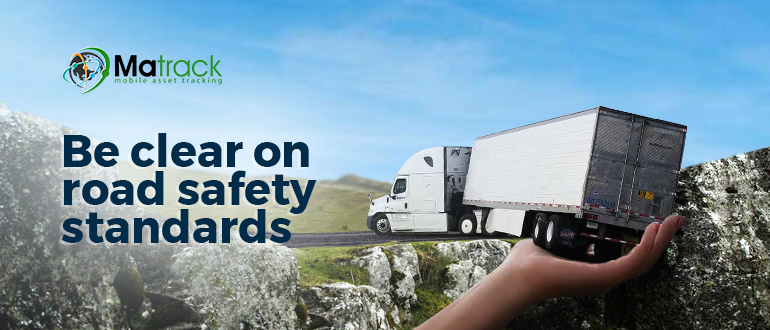Revisiting FMCSA’s Safety And Security Priorities Amid Global Crisis
Content
Key Takeaways:
- •Requirement of FMCSA Guidelines
- •Why to Revisit the FMCSA Achievements?
- •Safety Protocols
- •Role of Technology
- •GPS Tracking and Smart Video Solutions
- •Interactive Road Safety Module for the Truckers to Implement
The existing global crisis isn’t going anywhere but individuals and businesses must learn to live with the same, in order to sustain themselves, in the short and long run. With the US government on the verge of reopening several businesses to keep the economic activities intact, the movement of commercial vehicles is expected to resume, sooner than expected.
However, the post-covid19 era isn’t going to be the same. With the trucking industry taking a massive hit due to this catastrophic setback, it is time to consider certain pre-existing aspects before resuming operations.
Why the Commercial Vehicle Industry required Safety Guidelines in the First Place?
Commercial vehicle industry includes trucks, trailers, vans, and other entities that carry products from one point to the other. However, based on extensive surveys, almost 81 percent individuals are of the mind that commercial vehicle drivers show dangerous driving habits. While these trends were mostly synonymous to 2019, we expect the scenarios to persist even when the truckers and other commercial vehicles start plying post covid19 lockdown.
Commercial vehicle drivers are trying to fit in extensive working hours as most truckers pay them by the hour. The willingness to drive fast often leads to accidents, and this is why the FMCSA brought in the guidelines in the first place.
Moreover, with almost 69 percent of highly strollers known to witness speeding commercial trucks, it was a matter of time that certain guidelines came into existence.
Why Recapping of Safety Priorities is Necessary?
As mentioned, things will change once the US government lifts the extensive lockdown. However, after almost a two-month hiatus for certain fleets, it is quite difficult to get back onto the road, from a mental perspective.
Truckers are having hard time to sustain their workforce. Moreover, drivers are not getting paid adequately and tapping into their savings. Therefore, once they start working, concentrating will not be easy. The erratic mental state of the drivers might result in accidents as drivers will look to compete with others, in order to deliver additional freight.
Government’s Initiative to Concentrate on Safety
According to FMCSA or ‘Federal Motor Carrier Safety Administration’, it is necessary to improve road safety standards, in order to minimize collisions and other unfortunate activities. Therefore, the guidelines made sure that truckers adhere to the safety norms. While the achievements came to existence in 2019, they are more relevant now.
Based on the recent turn of events, the existing FMCSA guidelines aim at promoting safety, offering safety funding, keeping the trucking job opportunities alive, and even lowering the regulations which create burden on the trucking industry!
Each one of these initiatives focuses on the post-covid19 scenario.
Here are some of the regulatory achievements of the FMCSA, keeping the safety standards in mind:
- Funding of Critical Grants
This FMCSA achievement aims at offering grants to specific educational institutions and states. Here is one aspect that targets CMV safety with authorities allotting $77.3 million, for the same. Critical grants include HP grants amounting to $43.3 million and CDLPI grants of up to $32 million. These grants will surely come in handy once the lockdown ends and fleets are free to carry freight, across the states.
- Newer Technologies
Commercial vehicles require technological infusion to stay relevant to the existing landscape. FMCSA aims at adding newer technologies into the mix for reducing the chances of collisions and mishaps during fleet movements. While the inclusion of Automated Driving Systems is a decent idea, keeping the current scenario in mind, certain truckers can also include video monitoring, in the mix. A good way to keep up with the industry changes is by including GPS tracking into the mix.
- Increasing Awareness
At the end, it all comes down to the bus safety and truck-centric awareness. FMCSA has already partnered with numerous organizations to perpetuate a sense of road-based awareness. This includes teaching drivers about the industry standards, safety regulations, and other aspects of harmonious sustenance. Apart from that, the ‘Voice of Safety’ movement was introduced way back in 2019, in order to offer educational videos and campaign related awareness programs to the industry leaders, drivers, and other commercial participants.
- Helping Individuals with Jobs
Here is more of a sustenance policy which aims at job security for the commercial drivers. Apart from the driving workforce, anybody who is even remotely associated with the trucking sector can benefit from this FMCSA regulation. One aspect involves an effort to upgrade the commercial licenses from Class B to the more productive Class A. Allotted funds for the same amount to $18 million, each year.
- Targeting the HOS log
FMCSA realized that most accidents occur when drivers aren’t at ease and thinking about the ‘Hours of Service’ or HOS. With truckers paying drivers on the basis of HOS log, it is bound to create a sense of competition among the drivers. This factor isn’t good according to the road safety standards. FMCSA authorities make sure that there are multiple HOS regulations in play with almost $274 million backing up the same.
- Backing Military Members
FMCSA aims at recognizing the efforts of the US military services allowing individuals to operate trucks provided they have the licenses equivalent to the CDL. This approach makes sure that members from the military get ample professional opportunities. While this approach doesn’t cater to the safety standards directly, it aims at offering job support to a select group.
- Improving Underlining Regulatory Efficiency
FMCSA reforms aren’t new. They have been around for long and account for almost $366 million. The newest set of guidelines and standards, introduced in 2019, aim at improving the regulatory efficiency, by taking all the aspects into account. These include the introduction of the training regulations for the Entry-Level commercial drivers, HOS proposals, and more.
The Role of Technology in Commercial Vehicle Industry
Commercial vehicles need to be regulated. Furthermore, the pandemic and associated lockdowns have driven the US economy to the nadir with non-essential truckers feeling most of the heat. Therefore, if FMCSA is seriously reconsidering all the mentioned regulations and safety standards, relevant to the FMCSA safety score, it must first include ample technological innovations into the mix.
- GPS Tracking
The time is right to include EDL or even GPS tracking into the mix. A good thing about GPS fleet tracking is that truckers can use the same to ascertain the location of the drivers and the freight in general. When it comes to streamlining the commercial vehicle industry, it is necessary to bring in some additional eyes into the mix. This factor takes the GPS tracking into account.
A good thing about GPS tracking on commercial vehicles is that they can easily allow truckers to follow the location of the vehicle while braving inclement weather situations. The best case scenario here is to use a tracking system and safeguard trailers and commercial vehicles from accidents and mishaps.
- Smart and Effective Video Solutions
Another intuitive technology is the inclusion of smart, efficient, and productive video solutions. Based on real-time surveys, almost 42 percent of respondents believe that having something like a dash cam can easily prevent road accidents. To simplify things further, video solutions are preferred by most truckers as they test the drivers on a regular basis while even screening them before hiring.
These video solutions also help firms lay down rules and regulations based on the existing and probabilistic driving practices.
The Complete Safety Module for the Post-Covid19 Scenario
Apart from the standardized FMCSA regulations, individual truckers must concentrate and bring in safety modules for controlling the number of accidents. Road safety will become a major concern for the government in the coming years as the commercial vehicle drivers will try to outwit each other for increase HOS.
The complete safety module must include the following aspects:
- Driver Distraction Quotient

This aspect takes the psychological factors into account and considers hiring the drivers on the basis of certain personality tests.
- Driver Health
Medical checkups need to be conducted on a daily basis to eliminate health based threats.
- Hours of Service
The payment scenario must change in order to cut down on the competitive streak and even road rage.
- Driver Fatigue Levels
This aspect is directly proportional to the HOS. Companies must make sure that drivers do not end up working relentlessly. The priority should be to minimize fatigue and measure the levels of drowsiness before starting a journey.
- Road Sharing Guide
The interactive module should aim at teaching the drivers more about road sharing with the fellow professionals.
- Safety Systems
Proper knowledge regarding the video monitoring solutions and GPS tracking essentials is also necessary when it comes to ascertaining a detailed educational module about road safety.
With the US economy slowly coming out of the worst-ever crisis, it is time to channelize the strength of the commercial vehicles for kickstarting manufacturing, retail, and other businesses. However, during this period of extreme professionalism and competition, it is necessary to keep the road safety standards into account, while following the FMCSA guidelines in every possible manner. The entire commercial vehicle industry must concentrate on following the FMCSA standards and protocols while teaching drivers regarding the existing guidelines. Including driver safety incentive programs could reap incredible benefits too.
That said, truckers can always opt for credible security standards and solutions in Matrack; a company that aims at streamlining and securing fleet, drivers, and the freight in general. Based on the guidelines laid down by FMCSA, technology needs to play a pivotal role in guaranteeing safety for the vehicles and the drivers behind the wheel. Matrack takes care of all the requirements with robust, scalable, and weatherproof GPS solutions for every trucker who wants to make it big in the post-covid19 era.

